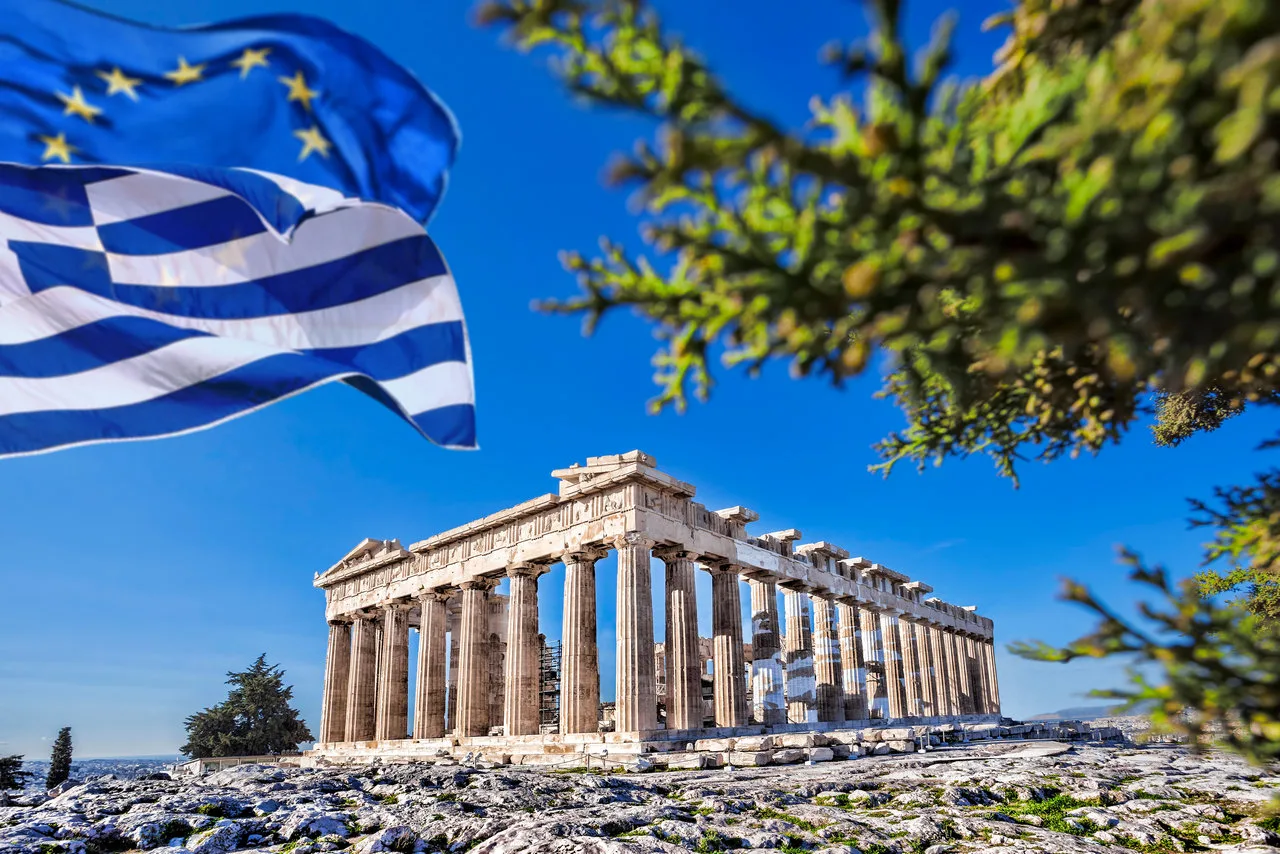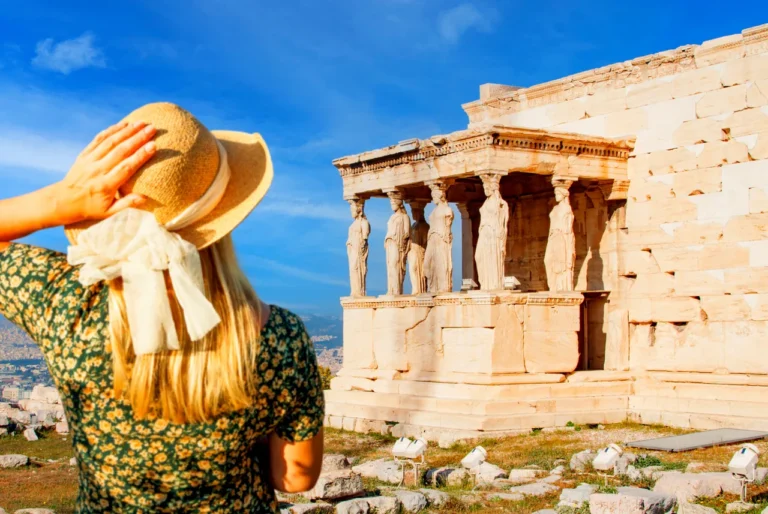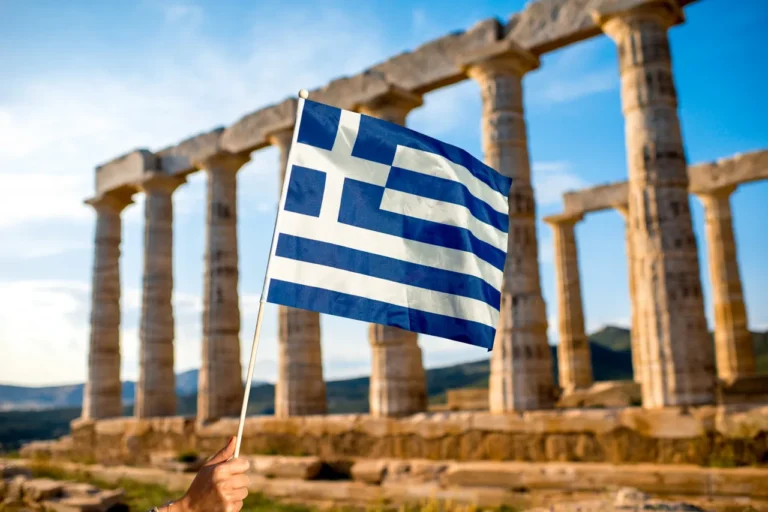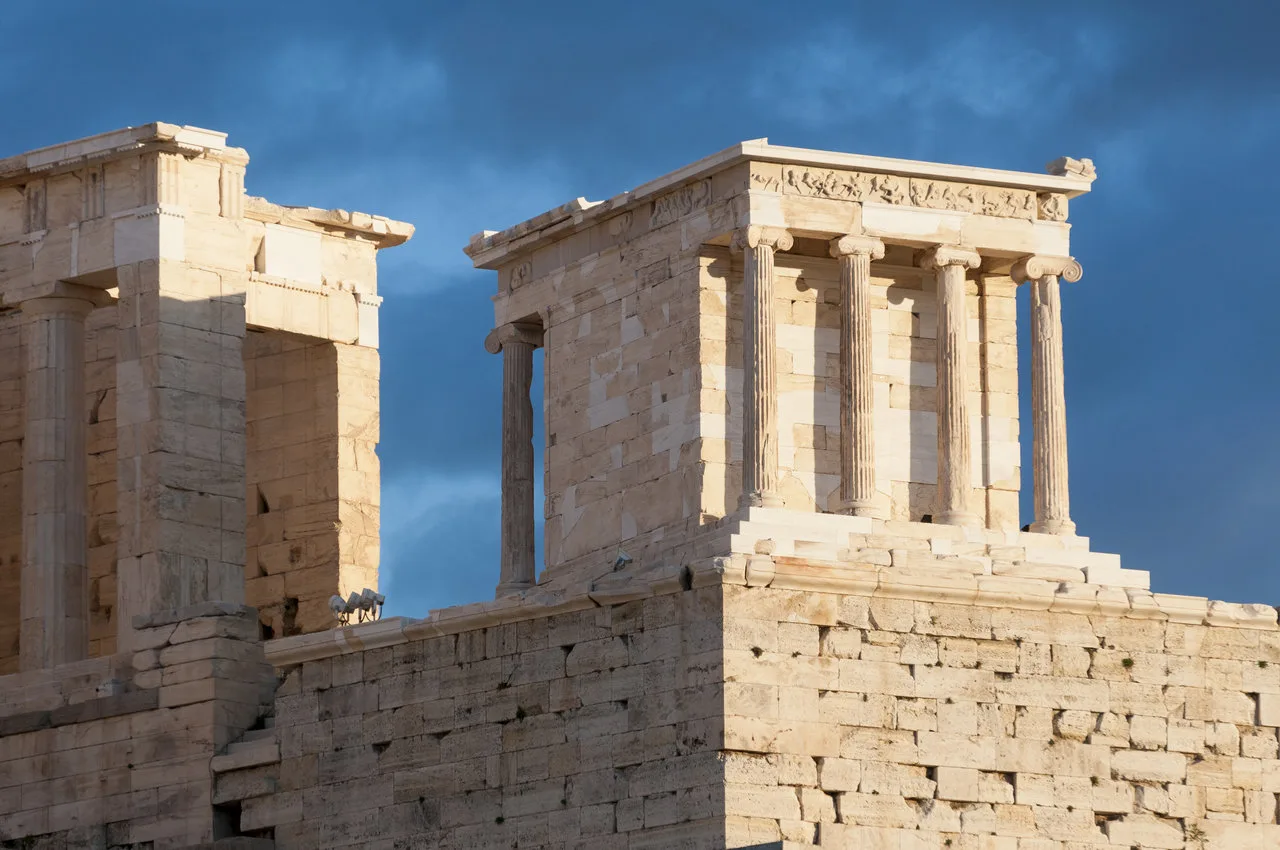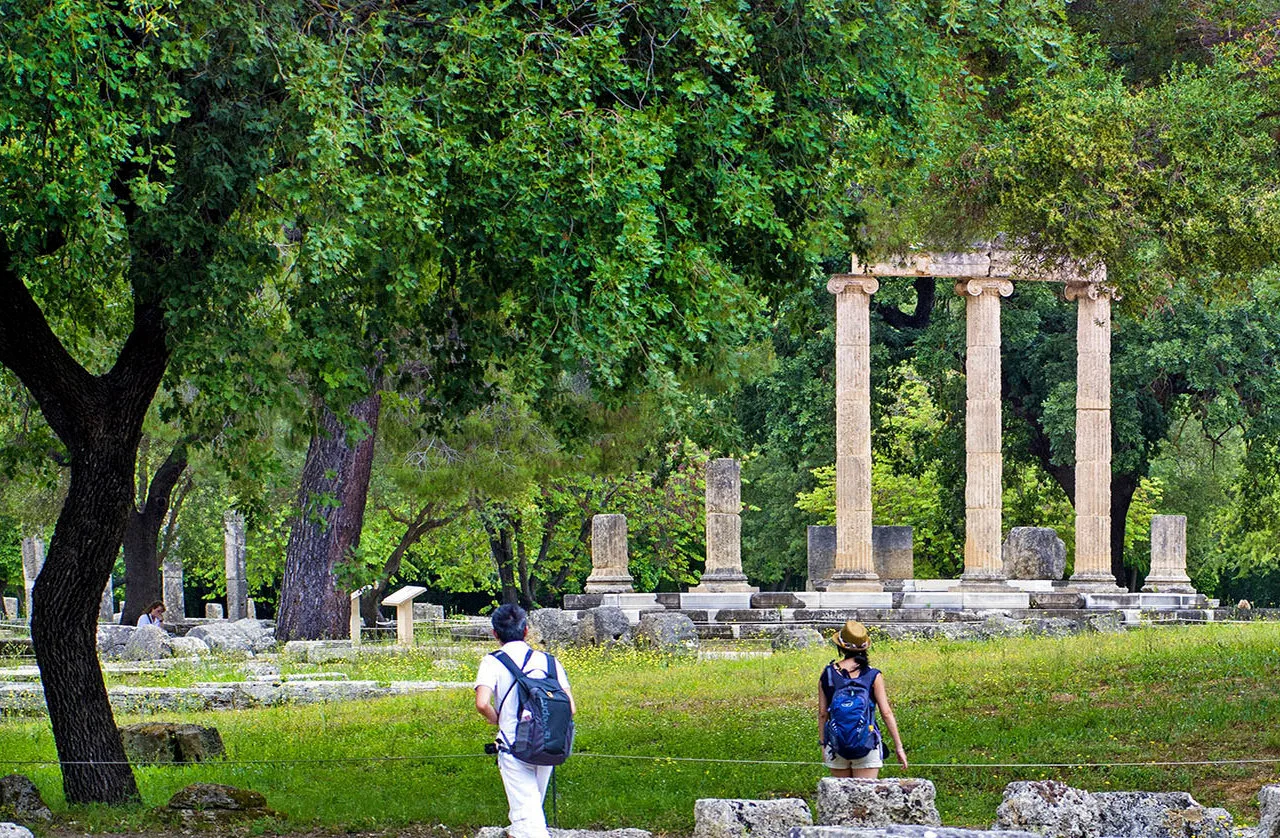Parthenon, Athens’ Crown Jewel
The Parthenon, a majestic temple crowning the Acropolis of Athens, stands as one of the most iconic symbols of Ancient Greece and its golden age. Built between 447 and 432 BCE under the visionary leadership of Pericles, this architectural marvel is dedicated to Athena Parthenos, the patron goddess of the city. The Parthenon’s harmonious proportions, innovative design, and exquisite sculptural decorations have captivated the hearts and minds of people for centuries, making it an enduring testament to the artistic and engineering prowess of the ancient Athenians.
What does the word Parthenon mean?
The word “Parthenon” is derived from the Greek word “Παρθενών” (parthenōn), which means “maiden’s chamber” or “virgin’s chamber.” This name refers to the temple’s dedication to the goddess Athena Parthenos, which translates to “Athena the Virgin.” In ancient Greek religion, goddess Athena was one of the most important deities, known for her wisdom, strategic prowess in war, and patronage of crafts and artisans. The epithet “Parthenos” emphasizes her virginal status, as she was believed to have never married or had children. The Parthenon was built to house a monumental statue of Athena Parthenos, which was made of gold and ivory (chryselephantine) and stood approximately 11.5 meters (38 feet) tall. This statue was the centerpiece of the temple and a symbol of the Athenians’ devotion to their patron goddess.
Tours including Parthenon
Visiting the Parthenon
Tips for Tourists
Visiting the Parthenon is a once-in-a-lifetime experience for many tourists. To make the most of your visit, it is recommended to arrive early in the morning or later in the afternoon to avoid crowds and heat. Visitors should wear comfortable shoes and bring water, sunscreen, and a hat. Guided tours are available and can provide valuable insights into the history and significance of the monument.
Read more: Opening hours and entrance fees for the Acropolis
The Acropolis Museum: Bridging Past and Present
The Acropolis Museum (link), located at the foot of the Acropolis, is a modern museum that houses the artifacts and sculptures from the Parthenon and other monuments on the sacred hill. The museum’s unique design allows visitors to view the Parthenon frieze in its original alignment and context, with the temple visible through the museum’s glass walls. The museum also showcases the ongoing restoration work, providing visitors with a behind-the-scenes look at the efforts to preserve the Parthenon for future generations.
Historical Context
The Golden Age of Athens
The Parthenon was constructed during the height of Athens’ power and influence, a period known as the Golden Age of Athens (480-404 BCE). Under the leadership of the statesman Pericles, Athens experienced a remarkable flourishing of art, architecture, philosophy, and democracy. The city’s wealth, derived from its position as the head of the Delian League, allowed for the financing of ambitious building projects, including the Parthenon.
The Parthenon is the centerpiece of the Acropolis, a sacred citadel that dominates the Athenian skyline. The Acropolis is a testament to the wealth, power, and artistic achievement of ancient Athens, with the Parthenon serving as its crowning jewel. The temple is surrounded by a complex of sacred buildings and monuments that together form a unified architectural and religious ensemble, including the Propylaea, the Erechtheion, and the Temple of Athena Nike.
Dedicated to Athena: Goddess of Wisdom
The Parthenon was dedicated to Athena Parthenos, the virgin goddess of wisdom, war, and crafts. As the patron deity of Athens, Athena was revered by the Athenians, and the Parthenon served as a symbol of their devotion and gratitude. The temple housed a colossal chryselephantine (gold and ivory) statue of Athena, sculpted by the renowned artist Phidias. This awe-inspiring statue, standing approximately 11.5 meters (38 feet) tall, was a testament to the Athenians’ wealth and their reverence for their patron goddess.
The Divine Contest: Athena vs. Poseidon for the Patronage of Athens
When the city was newly founded, it was not yet named, and the gods decided that the right to be the patron deity of the city should be granted to the god who offered the most useful gift to the people.
Poseidon, the god of the sea, struck the ground with his trident and created a saltwater spring (or in some versions, a horse). This gift was meant to symbolize the power and military might that Poseidon could offer the city.
Athena, the goddess of wisdom, crafts, and war, struck the ground with her spear and caused an olive tree to grow. The olive tree was seen as a symbol of peace, prosperity, and the agricultural wealth that Athena could provide.
The people of the city, who were asked to judge the contest, chose Athena’s gift as the more valuable one. They reasoned that the olive tree would provide food, oil, and wood, which were essential for the city’s survival and growth. Thus, Athena became the patron goddess of the city, which was named Athens in her honor.
This mythological story reflects the importance of olive cultivation in ancient Athens and the city’s strong association with Athena. The contest between Athena and Poseidon was a popular subject in ancient Greek art, with the most famous representation being the west pediment of the Parthenon, which depicted the moment just after the two gods had offered their gifts.
Architectural Grandeur
A Marvel of Doric Order
The Parthenon is considered the epitome of the Doric order, one of the three classical orders of ancient Greek architecture. The temple’s design is characterized by its simplicity, harmony, and proportions. The Parthenon measures approximately 69.5 meters (228 feet) in length and 30.9 meters (101 feet) in width, with a height of 13.7 meters (45 feet) from the stylobate to the roof.
Optical Refinements and Architectural Innovations
One of the most remarkable aspects of the Parthenon’s architecture is its incorporation of subtle optical refinements. The temple’s base is slightly curved upward, and the columns lean inward, creating an illusion of perfect straightness and symmetry. These refinements demonstrate the ancient Greeks’ deep understanding of human perception and their commitment to achieving visual perfection.
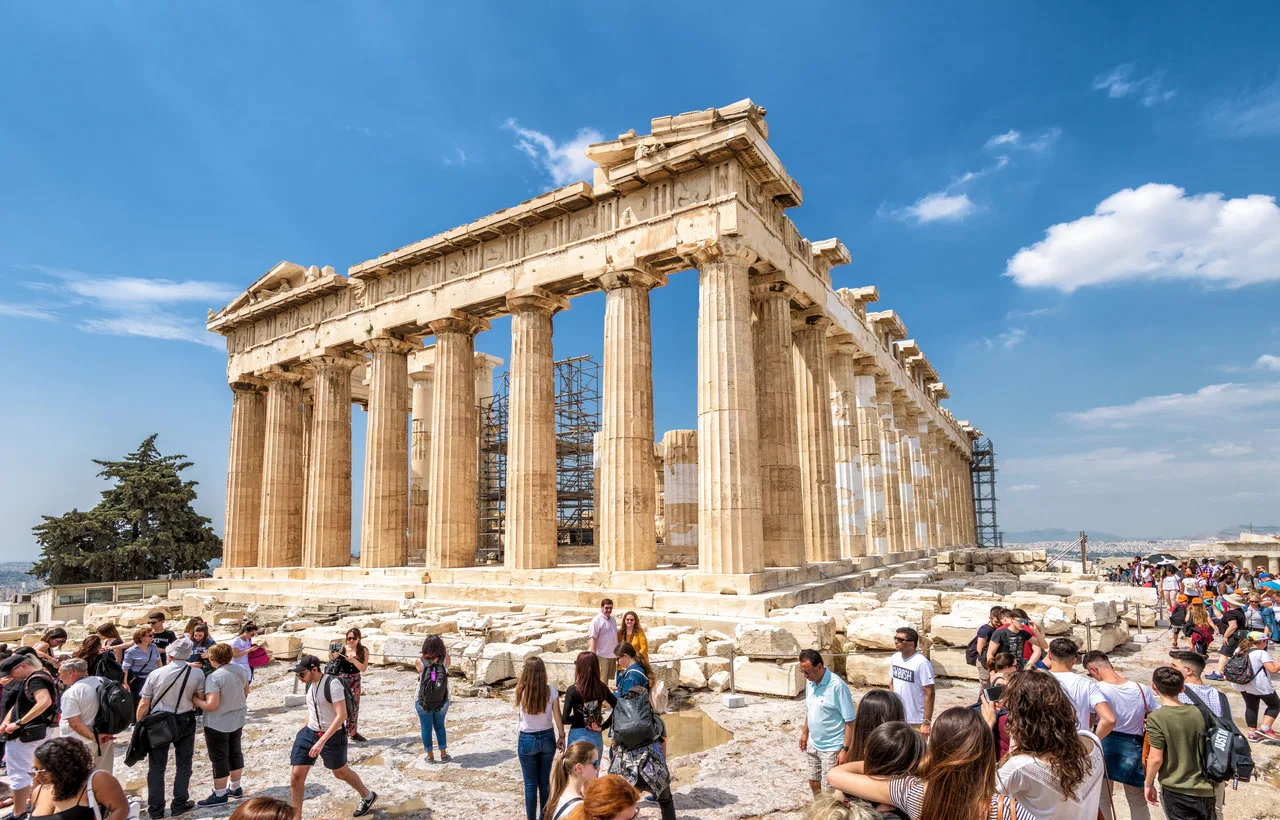
The Parthenon also showcases several architectural innovations, such as the entasis of the columns, which is a slight swelling in the middle to counteract the optical illusion of concavity. The temple’s peristyle consists of 8 columns on the east and west ends and 17 columns on the north and south sides, creating a grand and harmonious appearance.
Ictinus, Callicrates, and Phidias: Collaborating to Create a Masterpiece
The Parthenon was the result of the combined efforts and genius of several architects and artists. The two principal architects credited with the design and construction of the Parthenon are Ictinus and Callicrates, who worked under the supervision of the renowned sculptor Phidias.
Ictinus (Iktinos in Greek), the chief architect of the Parthenon, was a highly respected figure in ancient Athens. He was known for his innovative designs and his mastery of the Doric order, which is exemplified in the Parthenon’s harmonious proportions and subtle optical refinements. Ictinus had previously worked on other notable projects, such as the Temple of Apollo at Bassae, which showcased his ability to adapt the Doric style to create unique and striking architectural compositions.
Callicrates, the second architect associated with the Parthenon, was also a prominent figure in Athenian architecture. He collaborated with Ictinus on the design and construction of the temple, bringing his expertise and vision to the project. Callicrates was known for his attention to detail and his ability to oversee large-scale building projects efficiently. In addition to the Parthenon, he worked on other significant structures in Athens, such as the Temple of Athena Nike on the Acropolis and the Long Walls that connected Athens to its port city, Piraeus.
Phidias or Pheidias, the celebrated Athenian sculptor, played a crucial role in the artistic direction and oversight of the Parthenon’s construction. Although not an architect himself, Phidias was responsible for the temple’s sculptural decorations, including the iconic chryselephantine statue of Athena Parthenos that stood inside the Parthenon’s cella. His artistic vision and close collaboration with Ictinus and Callicrates ensured that the Parthenon’s architecture and sculptural elements worked together harmoniously to create a unified masterpiece.
The collaboration between these three masters – Ictinus, Callicrates, and Phidias – was essential to the creation of the Parthenon. Their combined skills, expertise, and artistic vision gave rise to a monument that has endured for centuries as a symbol of the golden age of Athens and the pinnacle of classical Greek architecture. It is worth noting that while Ictinus and Callicrates are the most well-known architects associated with the Parthenon, there were likely other architects, engineers, and craftsmen who contributed to the temple’s construction. The building of such a monumental structure would have required the efforts and skills of a large team of professionals working together under the guidance of the principal architects.
Sculptural Masterpieces
The Metopes and Their Stories
The metopes are the square panels that alternate with the triglyphs on the Doric frieze. The Parthenon features 92 metopes, each measuring approximately 1.2 meters (4 feet) square. The metopes depict various mythological scenes, including the Centauromachy (the battle between the Lapiths and the Centaurs), the Amazonomachy (the battle between the Greeks and the Amazons), the Gigantomachy (the battle between the Olympian gods and the Giants), and scenes from the Trojan War.
The Frieze: A Panoramic Procession
The Parthenon’s frieze is a continuous sculptural band that runs along the top of the temple’s cella walls. Measuring 160 meters (524 feet) in length and 1 meter (3.3 feet) in height, the frieze depicts the Panathenaic Procession, a grand festival held every four years in honor of goddess Athena. The frieze features over 360 human figures and more than 250 animals, including horses, cattle, and sheep, carved in low relief, creating a sense of depth and movement.
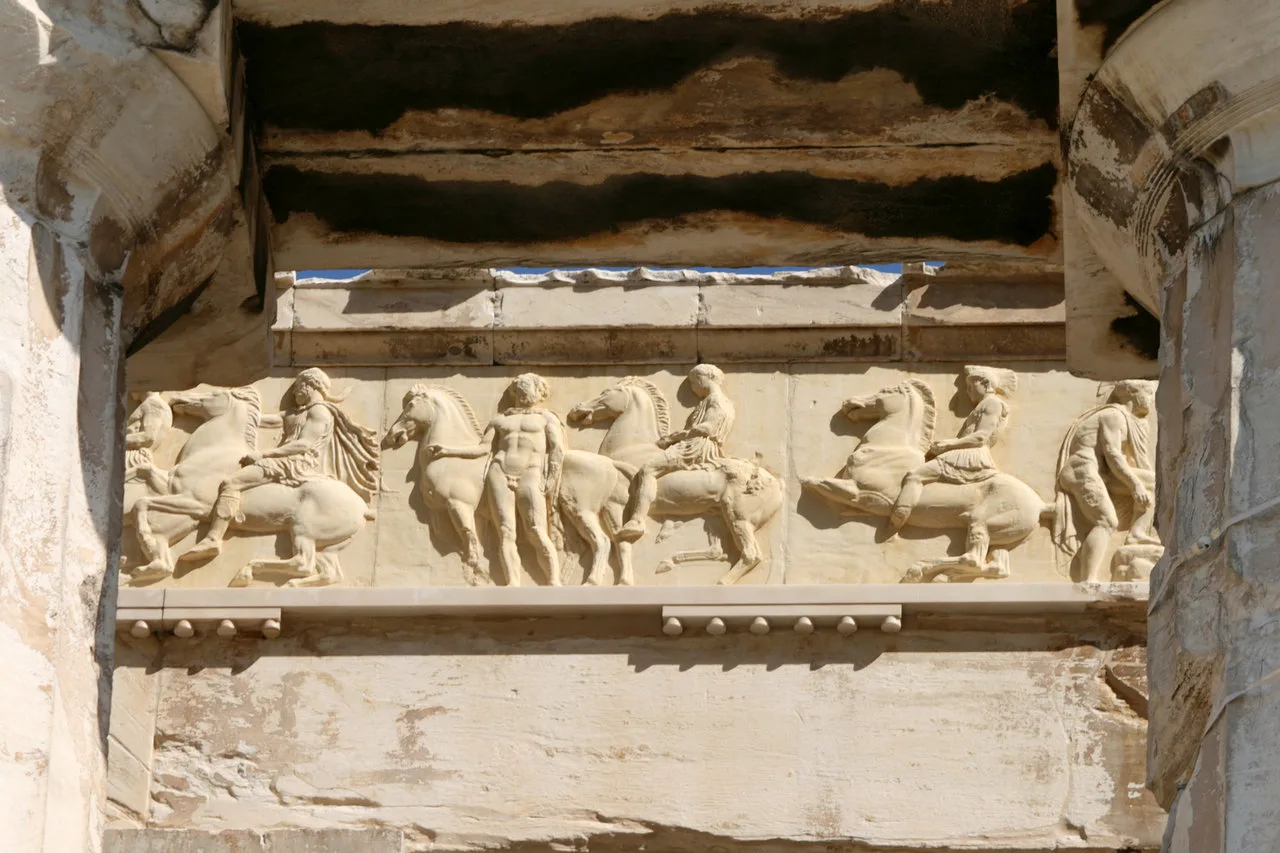
The Pediments: A Mythological Panorama
The pediments are the triangular spaces at the east and west ends of the Parthenon, featuring large-scale, freestanding sculptures that depict important mythological scenes related to Athena. The east pediment represents the birth of Athena, while the west pediment depicts the contest between Athena and Poseidon for the patronage of Athens. The pediment sculptures are remarkable for their naturalism, sense of movement, and emotional expression.
The Parthenon’s Role in Ancient Religion
Athena Parthenos: The Cult Statue
At the heart of the Parthenon stood the colossal cult statue of Athena Parthenos, created by the renowned sculptor Phidias. The statue, measuring approximately 11.5 meters (38 feet) tall, was made of gold and ivory over a wooden core. The cult statue was not merely a work of art but also a sacred object of veneration, embodying the essence and power of Athena herself.
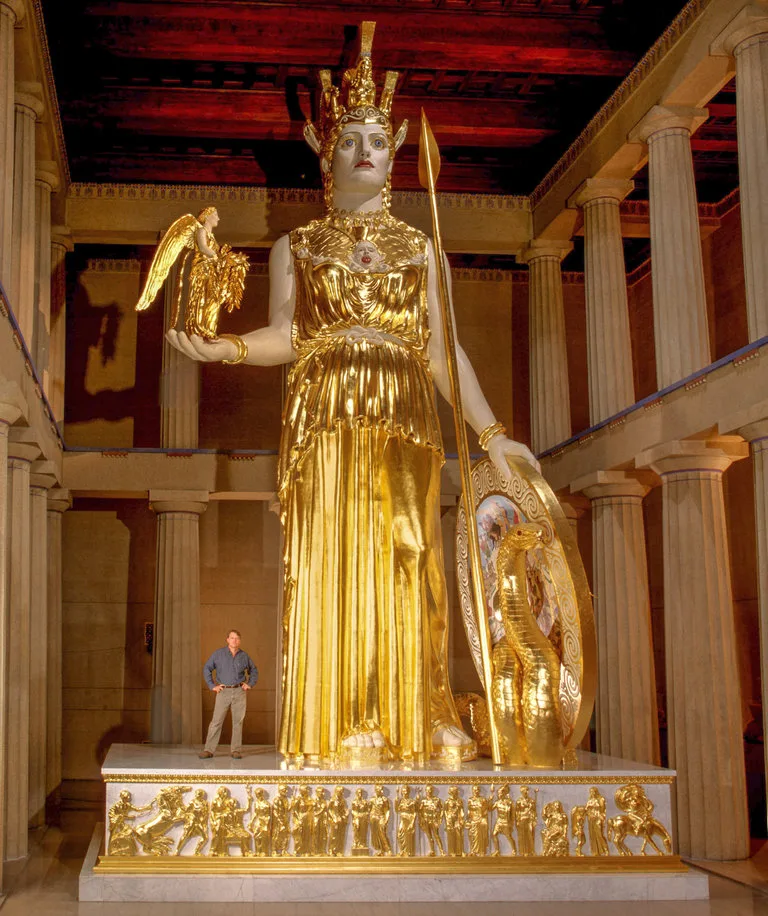
Religious Ceremonies and Festivals
The Parthenon served as the backdrop for various religious ceremonies and festivals throughout the year, the most important being the Panathenaic Festival. During this festival, a grand procession would wind its way through the city, culminating at the Parthenon, where a new peplos (a woven robe) was presented to the cult statue of Athena Parthenos. Other festivals and rituals associated with the Parthenon included the Chalkeia, a festival honoring Athena as the patron of crafts, and the Plynteria, a ritual cleansing of the cult statue.
The Parthenon through the Ages
From Temple to Church to Mosque
Throughout its long history, the Parthenon has undergone numerous transformations and faced various challenges. In the 5th century CE, the Parthenon was converted into a Christian church dedicated to the Virgin Mary. After the Ottoman conquest of Athens in 1458, the temple was transformed into a mosque. Despite these changes, the Parthenon remained largely intact until 1687, when a Venetian mortar round ignited the gunpowder stored inside the temple by the Ottomans, causing significant damage.
Destruction, Preservation, and Restoration
In the early 19th century, the Parthenon faced further damage due to the removal of sculptures by Lord Elgin, known as the Elgin Marbles. After Greece gained independence from the Ottoman Empire in 1832, efforts were made to preserve and restore the Parthenon. The Acropolis Restoration Project, initiated in 1975, is an ongoing effort to conserve and restore the Parthenon and other monuments on the Acropolis using modern techniques and materials.
The Elgin Marbles Debate
The Elgin Marbles have been a source of ongoing controversy since their removal from the Parthenon. The Greek government and many international organizations have called for the return of the marbles to Athens, arguing that they are an integral part of the Parthenon and should be reunited with the monument. The British Museum, however, maintains that the marbles were legally acquired and are accessible to a global audience in their current location.
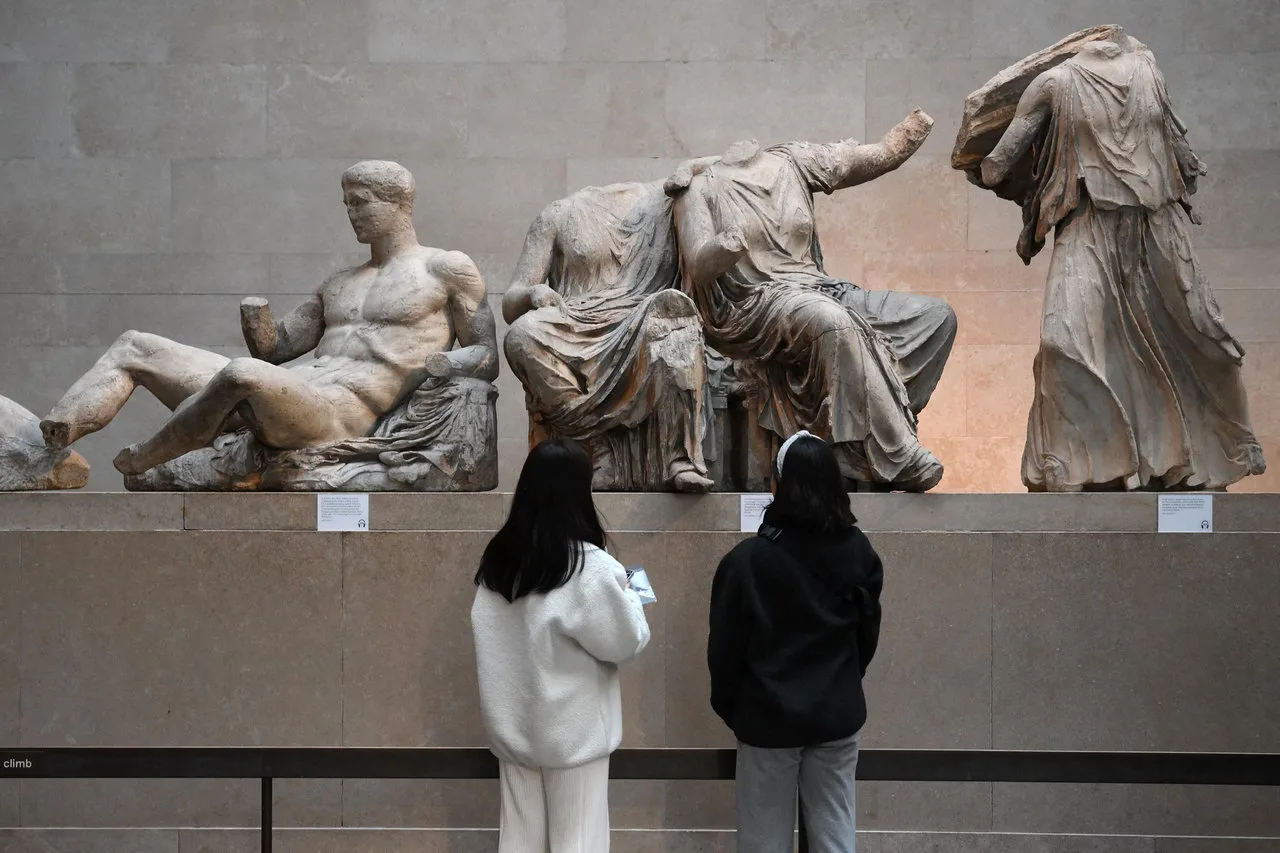
Modern Conservation Efforts
The Acropolis Restoration Project is a comprehensive effort to conserve and restore the Parthenon and other monuments on the Acropolis. The project involves the careful dismantling, cleaning, and reassembly of the temple’s architectural elements, using modern conservation techniques and materials. The goal is to address the damage caused by previous interventions, pollution, and weathering, while ensuring the long-term stability and preservation of the monument.
The Parthenon in Modern Culture: Symbol of Western Civilization
The Parthenon has long been regarded as a symbol of Western civilization, representing the ideals of democracy, philosophy, and artistic achievement. The temple’s harmonious proportions, innovative design, and enduring beauty have inspired countless artists, architects, and thinkers throughout history, cementing its status as an icon of human creativity and cultural heritage.
FAQs About the Parthenon
What was the primary purpose of the Parthenon?
The Parthenon was built as a temple dedicated to Athena Parthenos, the patron goddess of Athens. It served as a sacred space for religious ceremonies, festivals, and offerings to Athena, and also functioned as a treasury, housing valuable offerings and tributes from Athens’ allies.
How has the Parthenon’s structure survived through the centuries?
Despite facing numerous challenges, the Parthenon has survived due to its robust construction and the efforts of conservationists. The temple’s innovative design, including its precise column spacing and subtle optical refinements, has contributed to its structural integrity. Modern restoration projects, such as the Acropolis Restoration Project, have worked to preserve and protect the monument for future generations.
What are the Elgin Marbles, and why are they controversial?
The Elgin Marbles are a collection of sculptures, including a significant portion of the Parthenon’s frieze and pediment sculptures, that were removed from the temple by Lord Elgin in the early 19th century. The controversy surrounding the Elgin Marbles stems from the debate over their rightful ownership and location, with the Greek government and many international organizations arguing for their return to Athens, while the British Museum maintains their legal acquisition and global accessibility.
Can visitors enter the Parthenon today?
Visitors cannot enter the Parthenon itself, as the interior is not accessible to the public due to ongoing restoration work and the need to protect the monument. However, visitors can admire the temple’s exterior and walk around its perimeter on the Acropolis. The nearby Acropolis Museum provides a comprehensive experience, showcasing the Parthenon’s sculptures and artifacts, and offering views of the temple from its glass-walled gallery.
How does the Acropolis Museum complement the experience of the Parthenon?
The Acropolis Museum offers a modern and immersive experience that complements a visit to the Parthenon. The museum houses the artifacts and sculptures from the temple and other monuments on the Acropolis, providing a comprehensive understanding of their historical and artistic significance. The museum’s unique design allows visitors to view the Parthenon frieze in its original alignment and context, with the temple visible through the museum’s glass walls.
What were the original colors of the Parthenon sculptures?
Recent research has revealed that the Parthenon sculptures were originally painted in vibrant colors, contrary to the common perception of white marble. The ancient Greeks used a variety of pigments, including red, blue, green, and gold, to enhance the details and expressions of the sculptures, highlighting their mastery of painting and their desire to create a visually stunning and lifelike representation of their gods, heroes, and myths.
How long did it take to build the Parthenon?
The construction of the Parthenon began in 447 BCE and was completed in 438 BCE, with the decorative elements being finalized in 432 BCE. The temple took approximately 15 years to build, a remarkably short time considering its size, complexity, and the level of craftsmanship involved. The efficient construction was made possible by the wealth and resources of Athens at the time, as well as the skilled labor of architects, sculptors, and craftsmen.
What is the significance of the Parthenon frieze?
The Parthenon frieze is a continuous sculptural band that runs along the top of the temple’s cella walls, depicting the Panathenaic Procession, a grand festival held every four years in honor of Athena. The frieze is considered a masterpiece of ancient Greek art, showcasing the skill and creativity of the sculptors in capturing the movement, detail, and emotion of the procession’s participants. The frieze’s unique design and placement on the temple’s interior walls make it an integral part of the Parthenon’s artistic and religious significance.
How has the Parthenon influenced modern architecture?
The Parthenon has had a profound influence on modern architecture, serving as a model of classical design and proportions. Many famous buildings, such as the United States Capitol, the British Museum, and the Reichstag in Germany, have drawn inspiration from the Parthenon’s columns, pediments, and overall structure. The temple’s harmonious proportions and innovative design have been studied and adapted by architects throughout history, contributing to the development of neoclassical and Greek Revival styles, and demonstrating its timeless beauty and significance as a symbol of human achievement.
Conclusion
The Parthenon, a masterpiece of ancient Greek architecture and art, continues to captivate and inspire people around the world. Its enduring legacy is a testament to the genius of the ancient Athenians, who created a monument that embodies the ideals of beauty, harmony, and human achievement. Through its innovative design, exquisite sculptures, and role in ancient religion, the Parthenon has become an icon of Western civilization and a symbol of the enduring power of human creativity.
As we continue to study, preserve, and admire the Parthenon, we not only pay tribute to the remarkable achievements of the past but also draw inspiration for the future. The ongoing efforts to conserve and restore this architectural marvel ensure that future generations will have the opportunity to experience its grandeur and learn from its timeless lessons.
The Parthenon’s influence on art, architecture, and culture across the centuries demonstrates the universal appeal and significance of this ancient temple. Its legacy serves as a reminder of the importance of preserving and celebrating our shared cultural heritage, and the power of human ingenuity to create works of enduring beauty and meaning.
In conclusion, the Parthenon stands as a testament to the extraordinary achievements of the ancient Greeks and the enduring impact of their cultural legacy. As we continue to explore and appreciate this iconic monument, we are reminded of the timeless values of beauty, harmony, and the pursuit of excellence that have.
Resources:
- Acropolis Museum (link)
- Parthenon Frieze (link)
- Replica of the Parthenon at Nashville, USA (link)
- St Clair, W. (1998). Lord Elgin and the Marbles. Oxford University Press. (link)
- Kokkou, A. (1977). The Care for the Antiquities in Greece and the First Museums. Hermis. (In Greek) (link)
- Jenifer Neils (2005). The Parthenon, From Antiquity to the Present. (link)
- Michael B. Cosmopoulos. The Parthenon and its Sculptures. (link)
- Verri, Giovanni et al. “The Goddess’ New Clothes: the Carving and Polychromy of the Parthenon Sculptures.” Antiquity 97.395 1173–1192. (link)
- “Ancient Greek Architecture in Present Day Society.” ukessays.com. 11 2018. UKEssays. 04 2024 (link)

